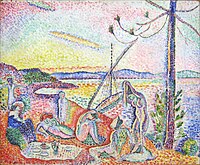
Neo-Impressionism
Neo-Impressionism is a term coined by French art critic Félix Fénéon in 1886 to describe an art movement founded by Georges Seurat. Seurat's most renowned masterpiece, A Sunday Afternoon on the Island of La Grande Jatte, marked the beginning of this movement when it first made its appearance at an exhibition of the Société des Artistes Indépendants (Salon des Indépendants) in Paris.[1] Around this time, the peak of France's modern era emerged and many painters were in search of new methods. Followers of Neo-Impressionism, in particular, were drawn to modern urban scenes as well as landscapes and seashores. Science-based interpretation of lines and colors influenced Neo-Impressionists' characterization of their own contemporary art.[2] The Pointillist and Divisionist techniques are often mentioned in this context, because they were the dominant techniques in the beginning of the Neo-Impressionist movement.
A Sunday Afternoon on the Island of La Grande Jatte
1884–1886
207.6 cm × 308 cm (81.7 in × 121.3 in)
Some argue that Neo-Impressionism became the first true avant-garde movement in painting.[3] The Neo-Impressionists were able to create a movement very quickly in the 19th century, partially due to its strong connection to anarchism, which set a pace for later artistic manifestations.[3] The movement and the style were an attempt to drive "harmonious" vision from modern science, anarchist theory, and late 19th-century debate around the value of academic art. The artists of the movement "promised to employ optical and psycho-biological theories in pursuit of a grand synthesis of the ideal and the real, the fugitive and the essential, science and temperament."[1]
Overview[edit]
Principles of aesthetic: light, color, and form[edit]
Seurat and his followers tried to give their painting a scientific basis, by painting tiny dabs of primary colors close to each other to intensify the viewer's perception of colors by a process of optical mixing. This created greater apparent luminosity because the optical mixing of colors tends towards white, unlike mixing of paints on the palette which tends towards black and reduces intensity.[4] Neo-impressionists also used more precise and geometric shapes to simplify and reveal the relationships between forms.[5] Seurat's disciple Paul Signac later used what he felt to be a more poetic spontaneous use of divisionist technique.[5]
The development of color theory by Michel Eugène Chevreul and others by the late 19th century played a pivotal role in shaping the Neo-Impressionist style. Ogden Rood's book, Modern Chromatics, with Applications to Art and Industry, acknowledged the different behaviors exhibited by colored light and colored pigment.[6] While the mixture of the former created a white or gray color, that of the latter produced a dark, murky color. As painters, Neo-Impressionists had to deal with colored pigments,[2] so to avoid the dullness, they devised a system of pure-color juxtaposition. Mixing of colors was not necessary. The effective utilization of pointillism facilitated in eliciting a distinct luminous effect, and from a distance, the dots came together as a whole displaying maximum brilliance and conformity to actual light conditions.[7]
Origins of the term[edit]
There are a number of alternatives to the term "Neo-Impressionism" and each has its own nuance: Chromoluminarism was a term preferred by Georges Seurat.[2] It emphasized the studies of color and light which were central to his artistic style. This term is rarely used today. Divisionism, which is more commonly used, describes an early mode of Neo-Impressionist painting. It refers to the method of applying individual strokes of complementary and contrasting colors.[2] Unlike other designations of this era, the term 'Neo-Impressionism' was not given as a criticism.[2] Instead, it embraces Seurat's and his followers' ideals in their approach to art. Note: Pointillism merely describes a later technique based on divisionism in which dots of color instead of blocks of color are applied; Signac rejected this term's use as synonymous for divisionism.[8]








